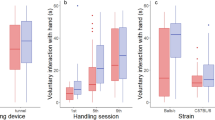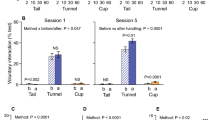Abstract
Routine laboratory animal handling has profound effects on their anxiety and stress responses, but little is known about the impact of handling method. We found that picking up mice by the tail induced aversion and high anxiety, whereas use of tunnels or open hand led to voluntary approach, low anxiety and acceptance of physical restraint. Using the latter methods, one can minimize a widespread source of anxiety in laboratory mice.


Similar content being viewed by others
References
Holson, R.R., Scallet, A.C., Ali, S.F. & Turner, B.B. Physiol. Behav. 49, 1107–1118 (1991).
Rodgers, R.J. & Dalvi, A. Neurosci. Biobehav. Rev. 21, 801–810 (1997).
Schmitt, U. & Hiemke, C. Pharmacol. Biochem. Behav. 59, 807–811 (1998).
Balcombe, J.P., Barnard, N.D. & Sandusky, C. Contemp. Top. Lab. Anim. Sci. 43, 42–51 (2004).
Leussis, M.P. & Heinrichs, S.C. Epilepsia 47, 801–804 (2006).
Wahlsten, D. et al. J. Neurobiol. 54, 283–311 (2003).
Deacon, R.M. Nat. Protoc. 1, 936–946 (2006).
Leach, M.C. & Main, D.C. Anim. Welf. 17, 171–187 (2008).
Ramos, A. Trends Pharmacol. Sci. 29, 493–498 (2008).
Henderson, N.D., Turri, M.G., DeFries, J.C. & Flint, J. Behav. Genet. 34, 267–293 (2004).
Barros, M. & Tomaz, C. Neurosci. Biobehav. Rev. 26, 187–201 (2002).
Augustsson, H., Dahlborn, K. & Meyerson, B.J. Physiol. Behav. 84, 265–277 (2005).
Roy, V., Merali, Z., Poulter, M.O. & Anisman, H. Behav. Brain Res. 185, 49–58 (2007).
Meddis, R. Statistics Using Ranks: A Unified Approach. (Basil Blackwell Publisher Ltd, Oxford, 1984.)
Acknowledgements
We thank R. Beynon, F. Fair, J. Waters, S. Roberts, M. Garratt, J.-F. Lemaitre, S. Ramm, M. Thom, S. Rounding and R. Humphries for practical assistance, and R. Beynon, P. Stockley, S. Roberts and J. Rees for comments on a draft manuscript. The study was funded by the Biotechnology and Biological Sciences Research Council, the National Centre for the Replacement, Refinement and Reduction of Animals in Research, the Wellcome Trust and the Association for the Study of Animal Behaviour.
Author information
Authors and Affiliations
Contributions
J.L.H. gained the funding and designed the project with contributions from R.S.W.; J.L.H. and R.S.W. collected data; and J.L.H. supervised all aspects of the work, analyzed the data and wrote the manuscript.
Corresponding author
Ethics declarations
Competing interests
The authors declare no competing financial interests.
Supplementary information
Supplementary Text and Figures
Supplementary Figures 1–6 and Supplementary Tables 1–5 (PDF 1665 kb)
Supplementary Movie 1
Example of the tail handling method. (MOV 2842 kb)
Supplementary Movie 2
Example of the tunnel handling method. (MOV 3685 kb)
Supplementary Movie 3
Example of the cup handling method on day 1 and on subsequent days. (MOV 5425 kb)
Supplementary Movie 4
Voluntary interaction after tail handling. Typical responses of BALB/c, C57BL/6 and ICR(CD-1) mice after handling in the ninth session. (MOV 7234 kb)
Supplementary Movie 5
Voluntary interaction after tunnel handling. Typical responses of BALB/c, C57BL/6 and ICR(CD-1) mice after handling in the ninth session. (MOV 6835 kb)
Supplementary Movie 6
Voluntary interaction after cup handling. Typical responses of BALB/c, C57BL/6 and ICR(CD-1) mice after handling in the ninth session. (MOV 7251 kb)
Supplementary Movie 7
Examples of first transfer from tunnel to hand using the combined method for C57BL/6 mice. (MOV 5429 kb)
Supplementary Movie 8
Voluntary interaction after combined tunnel to cup handling. Typical responses of C57BL/6 mice after direct cup handling in the ninth session. (MOV 5465 kb)
Rights and permissions
About this article
Cite this article
Hurst, J., West, R. Taming anxiety in laboratory mice. Nat Methods 7, 825–826 (2010). https://doi.org/10.1038/nmeth.1500
Received:
Accepted:
Published:
Issue Date:
DOI: https://doi.org/10.1038/nmeth.1500
- Springer Nature America, Inc.
This article is cited by
-
Anti-hyperalgesic and anti-inflammatory effects of 4R-tobacco cembranoid in a mouse model of inflammatory pain
Journal of Inflammation (2024)
-
3R-Refinement principles: elevating rodent well-being and research quality
Laboratory Animal Research (2024)
-
A mapping review of refinements to laboratory rat housing and husbandry
Lab Animal (2023)
-
Three-dimensional unsupervised probabilistic pose reconstruction (3D-UPPER) for freely moving animals
Scientific Reports (2023)
-
Experimenter familiarization is a crucial prerequisite for assessing behavioral outcomes and reduces stress in mice not only under chronic pain conditions
Scientific Reports (2023)





